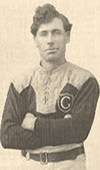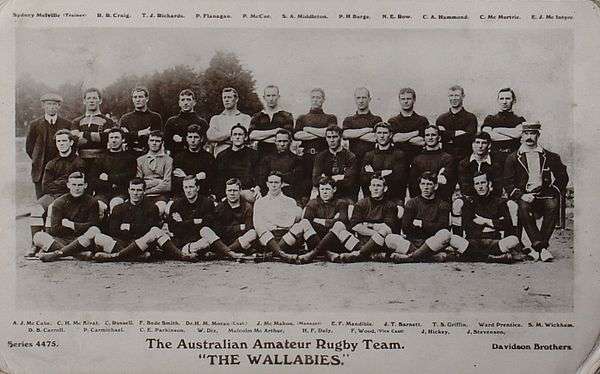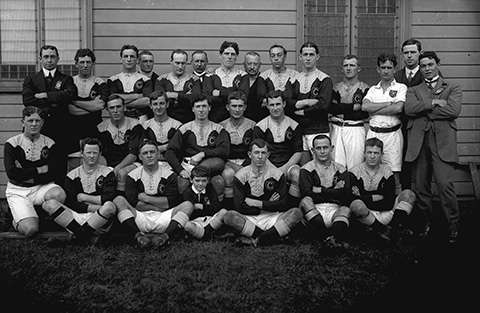Chris McKivat
| Olympic medal record | ||
|---|---|---|
| Men's Rugby union | ||
| | 1908 London | Team competition |
 | |||
| Wallaby Tourist 1908 | |||
| Full name | Christopher Hobart McKivat[1] | ||
|---|---|---|---|
| Date of birth | 27 November 1879[2] | ||
| Place of birth | Cumnock, New South Wales [1] | ||
| Date of death | 4 May 1941 (aged 61)[1] | ||
| Place of death | Camperdown, New South Wales | ||
| Height | 175 cm | ||
| Weight | 76 kg | ||
| Rugby league career | |||
| Position | Half-back | ||
| Professional clubs | |||
| Years | Club / team | Caps | (points) |
| 1910–14 | Glebe Dirty Reds | 54 | (15) |
| State Representation | |||
| Years | Club / team | Caps | (points) |
| 1910–12 | New South Wales | 13 | (15) |
| National teams | |||
| Years | Club / team | Caps | (points) |
| 1910–12 | Australia | 5 | (12) |
| Teams coached | |||
| 1915–20 1920–22 1928 |
Glebe Dirty Reds North Sydney Bears Western Suburbs Magpies | ||
| Rugby union career | |||
| Playing career | |||
| Position | fly-half[1] Five-eighth & halfback | ||
| Amateur clubs | |||
| Years | Club / team | ||
| 1895–1900 1900–05 1905 |
Bowen Brothers Wellington Glebe Rugby Union | ||
| Provincial/State sides | |||
| Years | Club / team | Caps | (points) |
| 1903–04 1905-1909 |
Central Western New South Wales |
? 16 |
|
| National team(s) | |||
| Years | Club / team | Caps | (points) |
| 1907–09[1] | Wallabies | 4[1] | (0)[1] |
Christopher Hobart McKivat (alternatively spelled McKivatt) (27 November 1879 – 4 May 1941) was an Australian rugby union and rugby league player – a dual-code rugby international. He represented the Wallabies in over 20 Tests and tour matches from 1907 to 1909 and the Kangaroos in 5 Tests from 1910 to 1912. He is unique in Australian rugby history as the only man to captain both the national rugby union and rugby league teams. Following his playing career he became the most successful coach of the North Sydney Bears in the club's history.[3]

Unique in history
He captained the 1908 Summer Olympics gold medal winning Wallaby side and was the eighth captain of the Australian national rugby league team leading them in all 3 Tests of the 1911–12 tour. Thus he captained his country to victory on tour in two different rugby codes.

Rugby union career
He was born in Cumnock, New South Wales and educated by the Patrician Brothers in Orange. He played country rugby union with the "Our Boys" club in Wellington and was regularly selected in country representative teams until he was 26. He was a tactically brilliant half-back and a great on-field leader of both forwards and backs.
Affectionately known as the "hairy bloke",[4] he moved to Sydney to join the Glebe Rugby Club in 1905 and played five-eighth for four seasons outside Fred Wood who would later be vice-captain of the 1908–09 Wallabies. McKivat was selected for New South Wales in 1905 to represent against the visiting All Blacks and then for the Wallabies in 1907 playing three Tests against the All Blacks. He was on the first Wallaby tour of the United Kingdom in 1908–09 and captained the side in 17 tour matches including the historic gold medal winning match against Cornwall representing England in the 1908 London Olympics.
Rugby league career

He crossed over to the professional code joining the Glebe Rugby League Club as a 30-year-old veteran in 1910.
He made his rugby league international debut that same year in the first Test in Sydney on 18 June 1910 against Great Britain. Four of his former Wallaby team mates also debuted that day John Barnett, Bob Craig, Jack Hickey and Charles Russell – making them collectively Australia's 11th to 15th dual code internationals. This repeated a similar occurrence two years earlier when five former Wallabies in Micky Dore, Dally Messenger, Denis Lutge, Doug McLean snr and Johnny Rosewell all debuted for the Kangaroos in the first ever Test against New Zealand.
The crowning achievement of his distinguished football career came on the 1911–12 Kangaroo tour of Great Britain when he captained Australia in all three Tests against Great Britain for two wins and one draw to a series victory that would not be equalled for more than 50 years
Australia's first Rugby League Ashes success was testament to his on-field genius and off-field leadership. He played in 31 matches on Tour (30 successive appearances) and scored 10 tries. The Heads/Middleton reference describes him a being revered on that tour – a magnificent general, tough, durable and an inspiration to the men around him. It quotes Johnny Quinlan the tour co-manager "He always set a splendid example in conduct and training – a natural leader"[5]
Chris McKivat is listed on the Australian Players Register as Kangaroo No. 67. [6]
His representative career ended at age 32 with that Ashes success and in retirement he became the first of the game's high-profile non-playing coaches. He coached Glebe, Wests and Norths in the following years, including North Sydney's premiership winning sides of 1921 and 1922.
Death
Christopher McKivat died on 4 May 1941 after a short illness. He died at Gloucester House, Royal Prince Alfred Hospital, Camperdown. He was survived by his wife and one son. [7]
A large funeral was held at St. James Church, Forest Lodge, New South Wales, and he was buried at Botany Cemetery. [8]
Accolades
The Heads/Middleton reference describes him as quiet, good humoured man off the football field, always immaculately dressed and often puffing on a cigar but a lesson in contrasts on the field – voluble, hard-driving and relentlessly barking orders.[5]
The Sydney Morning Herald said of him " He was described by Rugby and Rugby League authorities as the 'best' halfback of all time. No one possessed better all round ability. His service from the scrum was the speediest of any halfback since the coming of district football." [9]
In 2005 McKivat was admitted into the Australian Rugby League Hall of Fame.[10] In August 2006 he was named as coach of the North Sydney Bears' Team of the Century.
In February 2008, McKivat was named in the list of Australia's 100 Greatest Players (1908–2007) which was commissioned by the NRL and ARL to celebrate the code's centenary year in Australia.[11][12]
References
- 1 2 3 4 5 6 7 "Scrum.com player profile of Chris McKivat". Scrum.com. Retrieved 12 July 2010.
- ↑ Chris Cunneen, "McKivat, Christopher Hobart (1879–1941)", Australian Dictionary of Biography, volume 10, MUP, 1986.
- ↑ Phillips, Murray George (2000). From sidelines to centre field: a history of sports coaching in Australia. Australia: UNSW Press. p. 26. ISBN 978-0-86840-410-3.
- ↑ 2005 Annual Report Archived 5 July 2009 at the Wayback Machine. - Australian Rugby League (p. 50)
- 1 2 Heads, Middleton p47
- ↑ ARL Annual Report 2005
- ↑ Sydney Morning Herald: Death & Funeral Notice. 5 May 41 (pp 7,8)
- ↑ Sydney Morning Herald: Death of Famous Footballer. 5 May 41 (p12)
- ↑ Sydney Morning Herald - McKivat Obituary. 5 May 1941 (page 12)
- ↑ Australian Rugby League Hall of Fame
- ↑ Peter Cassidy (23 February 2008). "Controversy reigns as NRL releases top 100 players". Macquarie National News. Archived from the original on 25 February 2008. Retrieved 2008-02-23.
- ↑ "Centenary of Rugby League – The Players". NRL & ARL. 23 February 2008. Archived from the original on 26 February 2008. Retrieved 2008-02-23.
Footnotes
- Heads, Ian and Middleton, David (2008) A Centenary of Rugby League, MacMillan Sydney
- Whiticker, Alan (2004) Captaining the Kangaroos, New Holland, Sydney
- Howell, Max (2005) Born to Lead - Wallaby Test Captains, Celebrity Books, Auckland NZ
External links
- Chris McKivat at the Online Dictionary of Australian Biographies
- Chris McKivat biography at Sport Australia Hall of Fame
- profile
- Chris McKivat at the Orange Sporting Hall of Fame
| Preceded by Herbert Moran |
Australian national rugby union captain 1909 |
Succeeded by Sydney Middleton |
| Preceded by Bill Heidke |
Australian national rugby league captain 1911-12 |
Succeeded by Sid Deane |